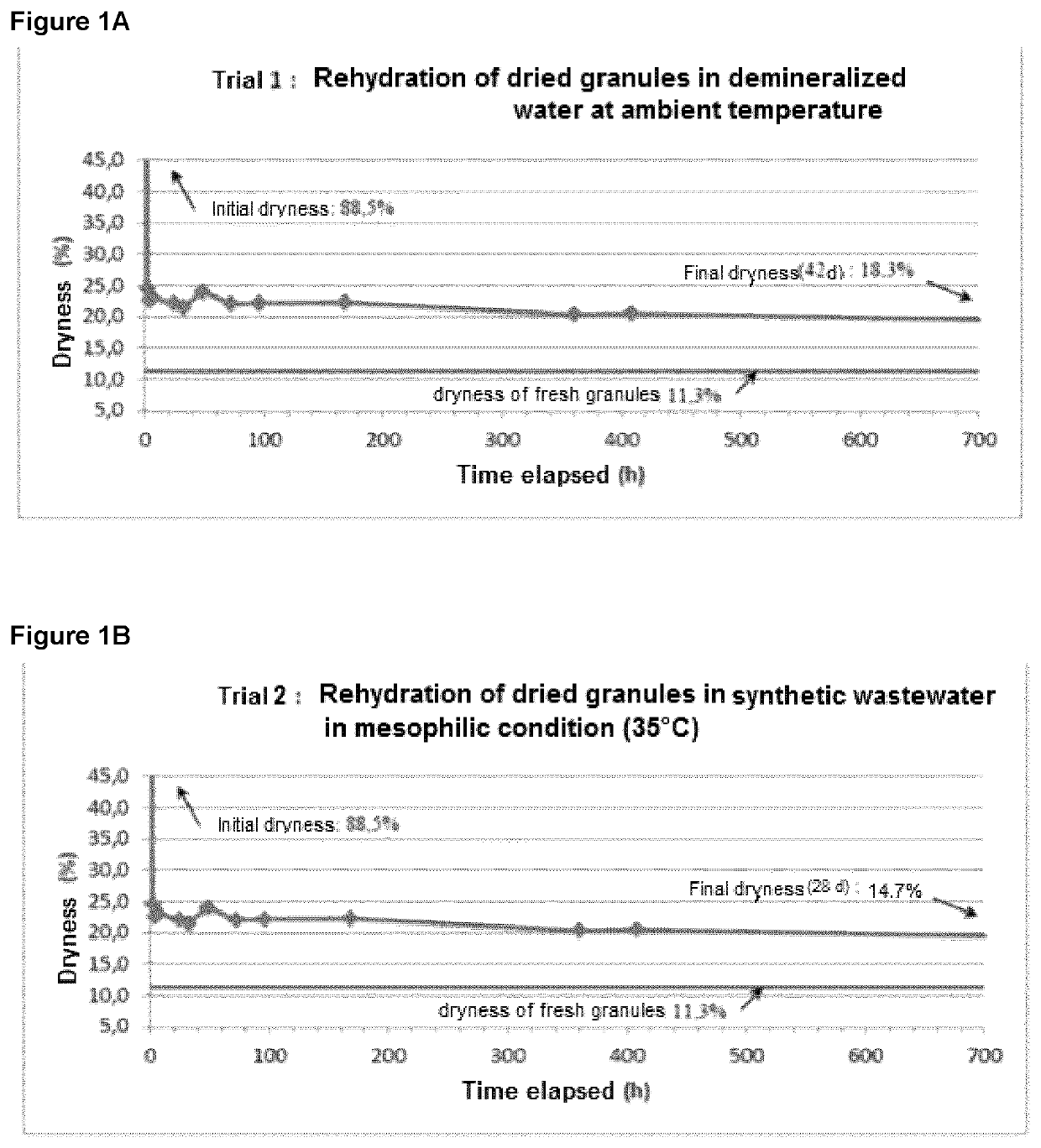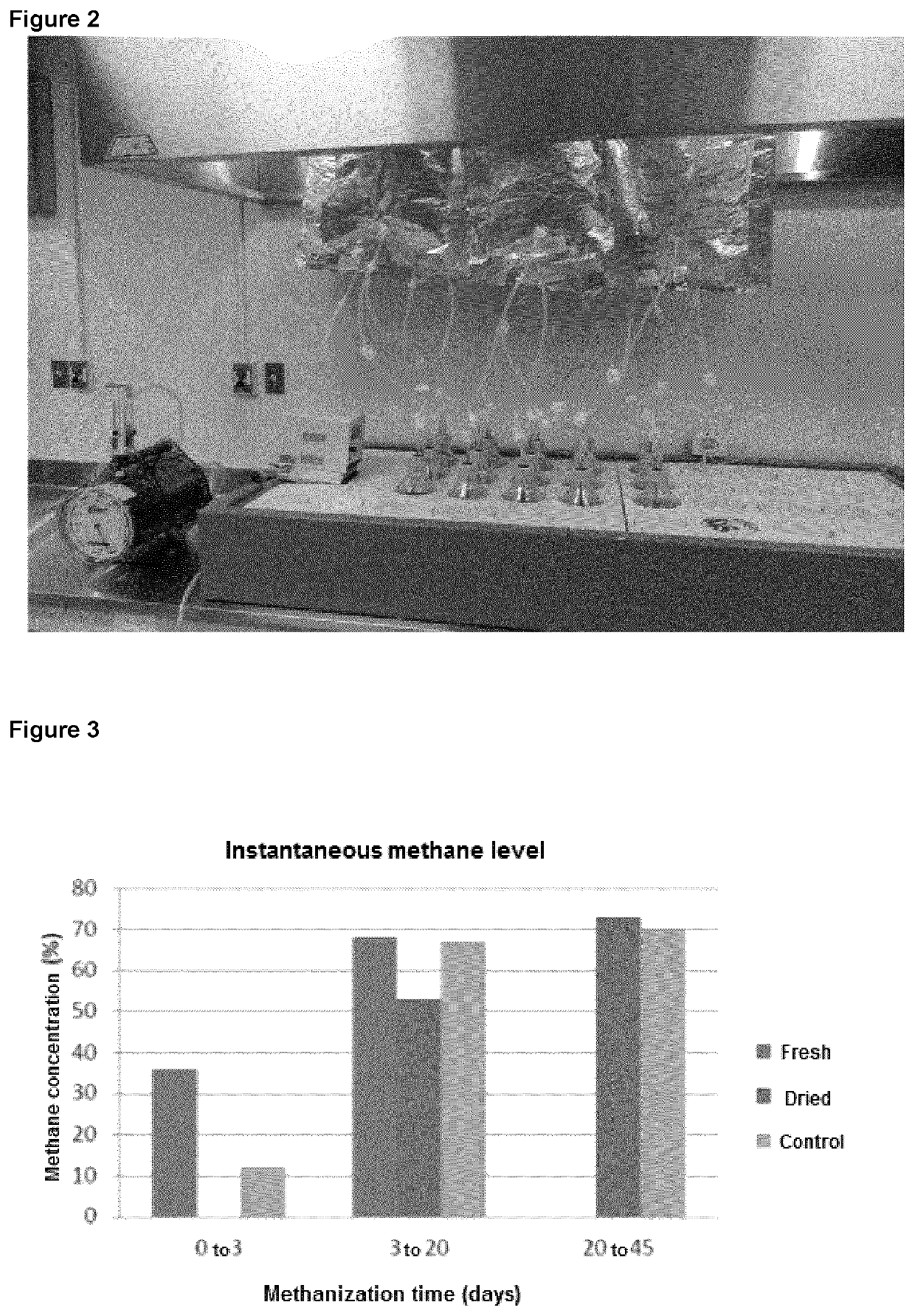Dried microbial sludge granule as additive for wastewater treatment
a technology of additives and microbial sludge, which is applied in the direction of biological water/sewage treatment, sustainable biological treatment, chemistry apparatus and processes, etc. it can solve the problems of inconvenient technology, difficult to remove the biomass from the treated wastewater, and produce biomass suitably robust to be used as a seed for other reactors, etc., and achieves the effect of improving the stability of the system and ensuring the effect of stability
- Summary
- Abstract
- Description
- Claims
- Application Information
AI Technical Summary
Benefits of technology
Problems solved by technology
Method used
Image
Examples
example 1
Preparing the Granules
[0082]The granules were recovered from excess granular anaerobic sludge from a biomethanization processing plant (Quebec). The sludge was drained from the bioreactor liquid phase to stop the biological activities. The sludge can come from any granular sludge bioreactor, preferentially UASB reactors. Other UASB reactors include paper mill effluent fed, cheese processing plant effluent, or any type of wastewater effluent.
[0083]The granules were then conveyed to a conventional air dryer. The temperature of the air generated can reach a temperature comprises between 20° to 60° C., preferably 40° C. The granules were then crushed and sieved to the desired particle diameter size, between about 200 microns to 4 mm. They were then sampled for DNA sequencing. Table 1 lists the bacteria communities found on the dried granules.
[0084]The dried bacterial granules can be bagged and stored in order to be used later as seeds or additive components for wastewater treatment syst...
example 2
on of Dried Granules
[0086]The study of speed and of rehydration rate of dried granules was carried out in two series of trials under different soaking conditions (soaking solution and temperature).
[0087]The analysis of the initial dryness (dry matter−MS %) was carried out as soon as the material was received. Two trials of the rehydration rate of the dried granules were carried out under the following conditions:
ConditionsFirst trialSecond trialSoaking solutionDemineralized waterSynthetic wastewater*TemperatureAmbient (±21° C.)Mesophile (35 ± 1° C.)*The composition of the synthetic wastewater is the one used in the Massalha study (2014)
[0088]The methodology used for the rehydration trials is summarized as follows:[0089]A serie of 12 bottles were prepared in which ±8.0 g of dried granules were soaked with 125 mL of demineralised water or synthetic wastewater according to the trial;[0090]The bottles were then incubated at the indicated temperature and stirred periodically to promote r...
example 3
n of the Potential of Dry Granules to Stimulate the Production of Biogas in an Anaerobic Reactor
3.1 Sample and Physicochemical Characterization of the Granules
[0097]The granule samples were stored under an atmosphere of nitrogen / carbon dioxide, at 35° C. A characterization of MS and MSV (dryness and organic matter) on the 3 types of granules (fresh, dry and control) was also carried out.
3.2 Preparation and Physicochemical Characterization of Synthetic Wastewater
[0098]In order to carry out the methanogenic trials, a synthetic wastewater was prepared. This water serves as a substrate for the granules during the trials. It is a substrate rich in carbon (mixture of glucose, yeast extract and peptone) and balanced to microbial nutrient needs (N, P, trace elements such as Ca, Mg, Zn, Cu, Fe, Mn, etc., pH and buffering capacity). The exact composition of the manufactured synthetic wastewater can be consulted in Massalha (2014)2 by doubling the concentration of the inorganic compounds and m...
PUM
 Login to View More
Login to View More Abstract
Description
Claims
Application Information
 Login to View More
Login to View More - Generate Ideas
- Intellectual Property
- Life Sciences
- Materials
- Tech Scout
- Unparalleled Data Quality
- Higher Quality Content
- 60% Fewer Hallucinations
Browse by: Latest US Patents, China's latest patents, Technical Efficacy Thesaurus, Application Domain, Technology Topic, Popular Technical Reports.
© 2025 PatSnap. All rights reserved.Legal|Privacy policy|Modern Slavery Act Transparency Statement|Sitemap|About US| Contact US: help@patsnap.com



